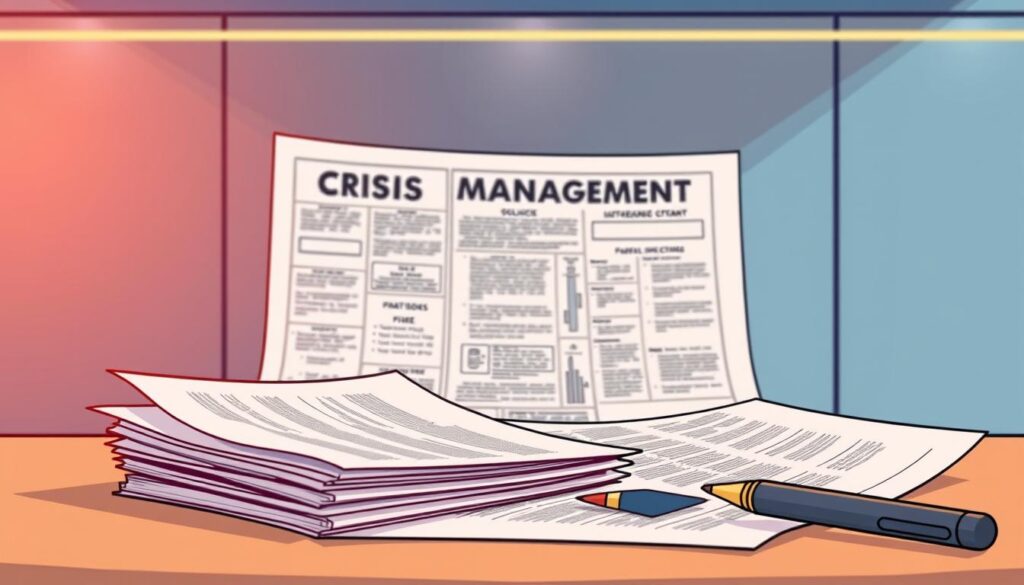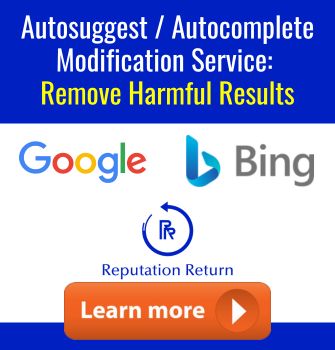In today’s digital age, a single post can either protect your brand or erode trust. Every moment counts when managing a media crisis, and having a solid communication plan is crucial. Whether it’s a TikTok video, Instagram Reel, or Twitter post, each piece of content plays a significant role in maintaining brand safety during turbulent times.
Proactive planning and effective post-crisis recovery go hand in hand. A well-structured crisis management plan ensures that your brand can navigate challenging situations with confidence. Our guide will walk you through essential monitoring practices, team roles, and communication strategies to help you stay ahead of potential issues.
At ReputationReturn.com, we understand the importance of protecting your online reputation. Our approach combines industry expertise with proven best practices to guide you through even the most difficult online moments. Don’t let a crisis define your brand—contact us today for a free and private consultation to discuss your needs and ensure your brand’s safety.
Key Takeaways
- Every digital communication impacts your brand’s trust and safety.
- A robust crisis communication plan is essential for effective media crisis management.
- Proactive planning significantly improves post-crisis recovery outcomes.
- Monitoring and team coordination are critical for managing a media crisis.
- Transparent and timely communication strengthens brand reputation during challenging times.
- A well-structured management plan ensures your brand navigates crises with confidence.
Understanding the Landscape of a Social Media Crisis
A single misstep online can escalate into a full-blown brand emergency, affecting trust and customer loyalty. Recognizing the signs of a potential crisis is the first step in effective management.
What Defines a Social Media Crisis?
A social media crisis occurs when a negative event or issue gains significant online attention, damaging a brand’s reputation. It often starts with a minor issue, like an insensitive post or product failure, which can quickly spiral out of control due to rapid sharing on platforms like Twitter or Instagram.
Common Triggers and Warning Signs
Brands like Marks & Spencer and Chipotle have faced crises due to product issues and customer complaints. Early detection is key, as platforms amplify problems through comments and shares. Monitoring brand mentions and sentiment shifts helps identify potential crises before they escalate.
| Trigger | Example | Impact |
|---|---|---|
| Insensitive Posts | Marks & Spencer’s controversial ad | Public backlash, loss of trust |
| Product Failures | Chipotle’s food safety issues | Decreased sales, reputational damage |
| False Claims | Misleading product information | Legal issues, customer distrust |
Understanding these factors is crucial for building a crisis communication plan that protects your brand during challenging times.
Recognizing Early Warning Signals
Staying ahead of potential issues is crucial in today’s fast-paced digital environment. Early detection of warning signs can make a significant difference in managing a crisis effectively.
Monitoring Brand Mentions and Sentiment
Continuous monitoring of brand mentions and overall sentiment is vital. Tools like TalkWalker and Hootsuite provide real-time insights, helping you track shifts in public perception. By setting up alerts for negative comments, you can address issues before they escalate.
Identifying Rapid Shifts in Online Conversations
Sudden changes in online discussions can signal potential crises. Utilizing social listening tools allows you to detect these shifts early, enabling prompt action to mitigate risks.
| Tool | Benefit |
|---|---|
| TalkWalker | Advanced social listening for real-time monitoring |
| Hootsuite | Comprehensive brand mention tracking |
| Google Alerts | Customizable alerts for mentions and keywords |
Proactive monitoring is essential for intercepting issues before they become crises. Early detection empowers you to communicate transparently, maintaining trust and safeguarding your brand’s reputation.
Crafting a Robust Crisis Communication Plan
A well-structured crisis communication plan is the cornerstone of effective brand protection during turbulent times. Every brand needs a clear roadmap to navigate challenges confidently, ensuring consistent and empathetic messaging.
Establishing Clear Messaging Protocols
Effective communication begins with defined protocols. Key messages should be concise and tailored to address the situation without ambiguity. A centralized approval process ensures consistency across all channels, preventing mixed signals that could worsen the situation.
| Component | Description | Importance |
|---|---|---|
| Key Messaging | Core messages addressing the crisis | Ensures clarity and consistency |
| Approval Process | Structured review before release | Maintains message alignment |
| Communication Channels | Selected platforms for outreach | Ensures reach and relevance |
Setting Guidelines Based on Audience Needs
Different audiences require tailored approaches. Understanding their concerns allows for more empathetic and relevant communication. For instance, customers may need reassurance, while stakeholders require detailed updates. Learn more about creating audience-specific guidelines.
Brands like Netflix have successfully navigated crises by adhering to well-structured plans. Their approach highlights the importance of preparation and clear communication. For personalized advice, contact us today.
Building an Effective Crisis Management Team
Constructing a dedicated crisis management team is vital for navigating any brand through challenging times. Clear roles and responsibilities ensure that every member knows their part, from front-line responders to legal advisors. This structured approach guarantees a swift and unified response, minimizing potential damage and fostering trust.
Assigning Roles and Responsibilities
Each team member plays a unique role. Front-line responders handle immediate public concerns, while internal communicators keep staff informed. Legal advisors ensure compliance, ensuring all actions align with regulations. Clearly defined responsibilities prevent confusion and ensure effective action.
Coordinating with Legal, Technical, and PR Professionals
Cross-departmental coordination is key. Legal teams assess risks, technical experts handle operational issues, and PR professionals craft public messages. This collaboration ensures a holistic response, addressing all facets of the crisis. For instance, Netflix’s structured approach during past crises highlights the importance of coordination.
Real-world examples show that a well-organized team is pivotal in managing crises effectively. Learn more about how a strong internal team is as essential as external communication in resolving issues swiftly.
Implementing a “social media crisis response” Plan
Effectively managing a crisis requires a structured approach. Having a clear plan ensures timely and consistent communication, which is crucial for maintaining trust.
Step-by-Step Response Strategy
A well-organized strategy is key to managing any situation effectively. Here’s how to implement your plan:
- Assess the situation quickly to understand the scope.
- Activate your crisis team to ensure a unified response.
- Communicate clearly with your audience to provide updates and reassurance.
Brands like Luke Combs and Biore have successfully used rapid response strategies to address issues promptly.
Developing Key Messaging and Triage Methods
Clear messaging is essential for addressing concerns effectively. Pre-approved messages ensure consistency and prevent mixed signals.
Triage involves categorizing incoming messages by urgency. Tools like Brand24 can help track mentions and detect potential crises early.
| Component | Description | Importance |
|---|---|---|
| Key Messaging | Core messages addressing the issue | Ensures clarity and alignment |
| Triage Process | Categorizing messages by urgency | Enables prioritized responses |
| Response Tools | Using tools for rapid action | Facilitates timely communication |
A well-structured plan minimizes confusion and bolsters trust during challenging times.
Selecting the Right Communication Channels
Choosing the right communication channels is essential for effectively managing a brand crisis. A well-structured communication plan ensures your message reaches the intended audience promptly and clearly. Whether it’s through social media, email, or traditional media, each platform has its role in crisis communication.
Prioritizing platforms to reach your audience
Understanding where your audience spends their time is crucial. For instance, if your target audience is primarily on LinkedIn, focusing your efforts there ensures your message is seen. Platforms like Twitter are ideal for quick updates, while LinkedIn might be better suited for detailed explanations. Aligning your channel choice with where your audience engages most helps maximize the impact of your communication.
TAILORING YOUR MESSAGE FOR DIFFERENT MEDIA
Each platform has unique characteristics that should influence your messaging approach. For example, visual-centric platforms like Instagram may require more image-focused content, while Twitter thrives on concise updates. Tailoring your message to fit the platform ensures it resonates better with your audience and maintains brand consistency.
For example, Google effectively uses Twitter for rapid updates during crises, while LinkedIn is utilized for more in-depth communications. This strategic approach ensures that the message is appropriately tailored to the platform’s strengths and the audience’s preferences.
Maintaining consistency across all channels is vital. A unified message strengthens brand identity and prevents confusion. Whether it’s a press release or a social media post, ensuring all communications align fosters trust and clarity.
By thoughtfully selecting and tailoring your communication channels, you can effectively navigate a crisis and protect your brand’s reputation. Strategic channel selection and message adaptation are key to ensuring your audience receives the information they need, when they need it.
Pausing and Adjusting Scheduled Social Media Content
When a crisis emerges, it’s essential to immediately assess your scheduled content. Continuing with pre-planned posts can lead to tone-deaf messaging, which might worsen the situation. This is why pausing and adjusting your social media content is crucial during such times.
Evaluating Pre-Planned Posts During a Crisis
Pre-scheduled posts are often created without considering unexpected events. During a crisis, these posts can appear insensitive or irrelevant, potentially causing more harm. It’s vital to review all upcoming content to ensure it aligns with the current situation and maintains a respectful tone.
Revising Your Content Calendar in Real Time
Adaptability is key in crisis management. Revising your content calendar allows you to address the situation thoughtfully. This might involve postponing non-essential posts or creating new content that acknowledges the crisis and reassures your audience.
| Importance of Pausing Content | Risks of Not Pausing | Benefits of Revision |
|---|---|---|
| Maintains brand sensitivity | Appears tone-deaf | Aligns messaging with crisis context |
| Prevents reputational damage | Undermines management efforts | Shows adaptability and empathy |
| Ensures timely communication | Missed opportunity for empathy | Maintains audience trust |
Utilizing social media management tools can help efficiently pause and reprogram content. These tools enable real-time adjustments, ensuring your messaging remains appropriate and sensitive. Dynamic content management is essential for maintaining brand integrity and trust during challenging times.
Crafting Timely and Empathetic Responses
When a crisis strikes, time is of the essence. Responding quickly yet thoughtfully is crucial to mitigating anxiety and maintaining trust. A well-crafted message can alleviate concerns and demonstrate empathy, showing your audience that you care.
Balancing Speed with Accuracy
While speed is critical, accuracy is equally important. Rushing to respond without proper fact-checking can lead to misinformation, worsening the situation. A balanced approach ensures your communication is both timely and reliable.
Maintaining Authenticity and Transparency
Authenticity and transparency are key to building trust. Real-world examples, like CEOs issuing heartfelt apologies, show how genuine responses can make a positive impact. For instance, the Kitebaby incident demonstrated that a well-calibrated apology can turn a crisis into an opportunity for growth.
Setting up an internal approval process helps maintain consistency in messaging. Clear and empathetic communication strengthens the bond between your brand and its audience, fostering trust and loyalty.
Ongoing monitoring allows for adaptability as new information arises. Empathy and transparency are essential in every response, ensuring your audience feels heard and valued. By balancing speed with accuracy, you can navigate crises with confidence and integrity.

Engaging with Your Audience in Real Time
Engaging with your audience in real time is crucial for maintaining trust and addressing concerns promptly. Real-time interaction allows brands to show empathy and transparency, which are vital during challenging times.
Strategies for Effective Comment and DM Management
Managing a surge in comments and direct messages requires a structured approach. Assigning a dedicated team to monitor and respond ensures timely and consistent communication. Tools like Hootsuite can help categorize feedback, allowing your team to prioritize urgent messages.
- Filter and categorize comments by urgency and sentiment.
- Use platform-specific features to adapt responses.
- Ensure all responses align with your brand’s voice and guidelines.
Active listening and real-time engagement can clarify misunderstandings and demonstrate your commitment to your audience.
Using Empathy to Rebuild Trust
Empathy is key to rebuilding trust. Responding with compassion shows your audience you value their concerns. A sincere apology or acknowledgment can significantly impact perception.
“Empathy is the bridge that reconnects a brand to its audience during tough times.”
Combining empathy with clear communication strengthens relationships and fosters loyalty. For personalized advice, visit our expert consultation services.
| Strategy | Benefit |
|---|---|
| Real-Time Engagement | Builds trust and transparency |
| Empathetic Responses | Rebuilds trust and strengthens relationships |
| Team Coordination | Ensures consistent and timely communication |
By engaging thoughtfully and responding with empathy, you can navigate challenges and protect your brand’s reputation.
Leveraging Technology and Social Listening Tools
Modern technology plays a pivotal role in detecting potential issues early and enabling swift, organized responses. Advanced tools like Hootsuite and TalkWalker offer real-time social listening, allowing brands to monitor online conversations and identify emerging crises before they escalate.
Integrating Analytics for Early Detection
These platforms analyze vast amounts of data from platforms like Twitter, Facebook, and LinkedIn. Sentiment analysis tools can detect shifts in public opinion, providing early warnings of potential crises. For example, a sudden spike in negative mentions can signal a growing issue that needs immediate attention.
Automating Monitoring and Response Processes
Automation streamlines crisis management, reducing response times and ensuring consistent communication. Tools can categorize incoming messages by urgency, allowing teams to prioritize critical issues. This structured approach minimizes confusion and ensures a unified response, which is essential for maintaining trust.
By integrating analytics and automation, brands can refine their communication strategies. Real-time insights enable more informed decision-making, ensuring that responses are both timely and effective. This proactive approach not only mitigates damage during a crisis but also strengthens a brand’s reputation in the long run.
Ensuring Internal Alignment During a Crisis
Effective crisis management begins with a unified team effort. Internal alignment is crucial to ensure everyone is on the same page, from the executive team to front-line employees. When team members are well-informed and coordinated, the organization can respond more efficiently and maintain a consistent message.
Implementing Internal Communication Strategies
Clear communication channels are the backbone of any successful crisis management plan. Establishing a centralized system for sharing updates ensures that all departments receive the same information simultaneously. This approach minimizes misunderstandings and ensures that every team member knows their role.
Keeping Teams Informed and Coordinated
Regular updates and briefings are essential for maintaining alignment. Daily check-ins or real-time notifications through platforms like Slack or Microsoft Teams can keep everyone informed. Additionally, designating a single point of contact for critical information helps prevent confusion and ensures that all communications are consistent.
| Strategy | Benefit |
|---|---|
| Centralized Communication System | Ensures all teams receive the same information |
| Regular Updates | Maintains team alignment and awareness |
| Designated Point of Contact | Prevents misinformation and confusion |
By fostering open lines of communication and ensuring that all employees are informed, organizations can respond to challenges more effectively. Aligned teams not only enhance external communication but also strengthen the organization’s ability to manage crises efficiently.
Evaluating and Improving Your Crisis Management Plan
Once the dust settles, it’s crucial to evaluate your crisis management plan’s effectiveness. Understanding what worked and what didn’t is key to enhancing future responses. This process involves a thorough review of every action taken, from communication strategies to team coordination.
Conducting Post-Crisis Analysis
- Review every phase of the response to identify strengths and areas for improvement.
- Analyze both qualitative feedback and quantitative data to gauge effectiveness.
- Highlight what worked well and document weaknesses for adjustment.
This comprehensive approach ensures that every aspect of the plan is scrutinized, providing a clear roadmap for future enhancements.
Incorporating Lessons Learned for Future Preparedness
Integrating insights from past crises strengthens your strategy, making your organization more resilient. Adjusting your plan based on lessons learned ensures better preparedness for future incidents. Regular reviews of communication protocols and team performance are essential for sustained improvement.

Continual refinement is vital for maintaining an effective crisis management framework. By learning from each experience, your organization can navigate future challenges with greater confidence and efficiency.
Contact ReputationReturn.com for a Free and Private Consultation
Protecting your brand’s online reputation is crucial in today’s digital landscape. At ReputationReturn.com, we specialize in safeguarding your digital presence with comprehensive solutions tailored to your needs. Our team of experts is here to help you navigate any challenges with confidence.
We offer a free and private consultation to assess your unique situation and provide personalized strategies. This is your first step toward securing your brand’s future in an ever-evolving online environment.
Our approach combines cutting-edge tools with proven methodologies to address your concerns effectively. Whether you’re facing immediate threats or seeking preventive measures, we have the expertise to guide you.
Don’t let uncertainty jeopardize your brand’s integrity. Act now and take the first step toward a safer digital future. Contact us today to schedule your consultation and discover how we can help you maintain a strong online presence.
Conclusion
In today’s interconnected world, a well-prepared management plan is essential for safeguarding your brand’s reputation. The strategies outlined in this guide—ranging from proactive planning to real-time engagement—provide a clear roadmap for navigating challenges with confidence.
A unified team and clear communication are at the heart of effective crisis management. By addressing issues with both speed and empathy, you protect your brand’s credibility and foster trust. Remember, continuous evaluation and improvement are key to future preparedness.
Reflect on the actionable steps provided and consider how they can enhance your approach. A well-structured management plan is not just a strategy—it’s the cornerstone of your brand’s digital safety. Take the first step today and ensure your brand is ready for whatever tomorrow may bring. Contact us for a free consultation and discover how we can help you maintain a strong online presence.
FAQ
What steps should we take to handle a reputation crisis online?
Start by assessing the situation, then engage with your audience transparently. Use clear, empathetic communication to address concerns and outline your plan to resolve the issue.
How can we monitor brand mentions effectively?
Implement advanced listening tools to track mentions and analyze sentiment. This helps identify potential issues early, allowing for quicker, more effective responses.
What defines a crisis versus a minor issue?
A crisis is characterized by rapid escalation, significant public attention, and potential harm to your brand. Minor issues can often be resolved with a prompt, straightforward response.
How quickly should we respond to negative feedback?
Respond as soon as possible, ideally within minutes. Timely responses demonstrate accountability and empathy, helping to mitigate further damage.
Can we prevent a crisis from occurring?
While not all crises can be prevented, proactive monitoring and clear communication strategies can reduce risks and improve preparedness for potential issues.
What role should employees play during a crisis?
Ensure employees are informed and aligned with your communication strategy. They should avoid speculation and direct inquiries to your crisis management team.
How do we measure the success of our response strategy?
Success is measured by the resolution of the issue, positive sentiment recovery, and the restoration of your brand’s reputation over time.
Should we ever delete negative comments?
Generally, no. Deleting comments can escalate the situation. Instead, address concerns constructively to show your commitment to resolving the issue.
How long does it take to recover from a reputation crisis?
Recovery time varies depending on the severity and your response. Consistent, transparent communication is key to rebuilding trust and restoring your reputation.
Can ReputationReturn help us with our crisis management plan?
Yes, ReputationReturn offers expert guidance and tools to manage and recover from online crises. Contact us for a free, confidential consultation to discuss your needs.















